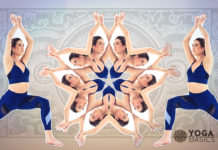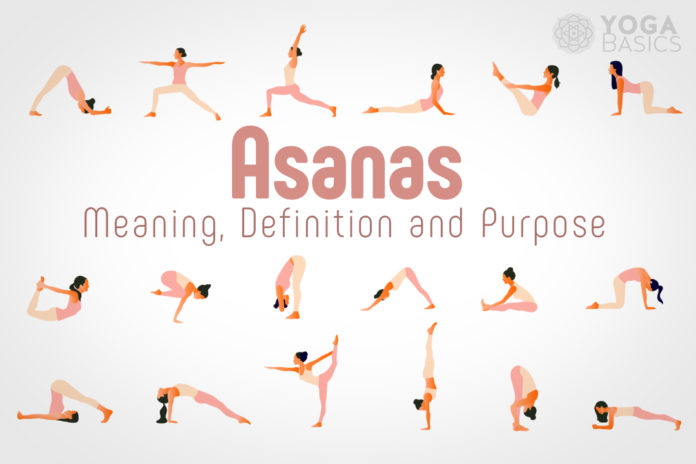Anyone who’s taken a yoga class has probably heard the term “asana.” Asanas are the physical body positions or poses of yoga that form the foundation of a modern hatha yoga practice. While most classes only teach the basics, there is a wide range of difficulty and complexity of the yoga asanas. To fully understand and learn the asanas, we will need to uncover the history of them, their origin, and how they’re used today in yoga. Gaining this knowledge opens up the doors for us to have a deep, profound and insightful practice.
Asana meaning and definition in Yoga
Asana is a Sanskrit word meaning “posture,” “seat,” or “place.” Asanas are the physical positions we assume during a hatha yoga practice. Each pose has its own Sanskrit and English name. Almost all of the Sanskrit names for the poses end with “asana.” For example, the classic lotus pose is named Padmasana, and the common tree poses is named Vrikshasana. Many of the asana names have come from the shapes and movements of animals and elements of the natural world. Some names differ by different schools of yoga, and some of the names have changed over time. There are several asanas that have been known by multiple names at different time periods.
There are many different types of poses, but they all follow the same basic principles of alignment and muscular engagement. They include everything from simple twists and backbends to advanced balancing poses. There can be many variations on the individual poses, and each variation has its own benefits, purpose and challenges.
An asana can be performed as a still and static position that can be held for several breaths, or it can be a posture that is part of a dynamic flowing movement that lasts for less than one inhale or exhale. The period of time it is held is dependent on the school of yoga followed and the intensity and difficulty of the physical posture. For example, Iyengar Yoga emphasizes yoga anatomy and physical alignment so the poses are held a while. In contrast, Ashtanga Yoga and Vinyasa styles move quickly between poses linking movements with breath as in the sun salutations.
While there is no wrong way to do any asana, there are a general principles of alignment, breathing techniques, and mindfulness that should be followed to prevent injury and maximize the benefits of yoga.
How many yoga postures are there?
Patanjali’s Yoga Sutras was one of the first yogic texts to mention the word asana. Patanjali includes it as one of the eight limbs of yoga and in sutra 2.47 he notes that asana should be “steady and comfortable.” The classic Hatha Yoga Pradipika text describes 18 postures but goes on to state that “Shiva taught 84 asanas.” Yet a later text called The Gheranda Samhita notes that “there are 8,400,000 asanas described by Shiva. The postures are as many in number as there are numbers of species of living creatures in this universe. Among them 84 are the best; and among these 84, 32 have been found useful for humankind in this world.” Most yoga teachers only lead about 15-25 poses in their classes. YogaBasics’ pose directory has 120 of the main modern asanas listed with photos and step-by-step instructions.
The history of the asanas
The original asanas were simple seated positions designed to be performed by yogis during meditation. They were steady yet comfortable shapes designed to focus the mind and calm the nerves and allow one to enter a deep meditative state.
Since those early days, more and more asanas were created for different reasons. In the 11th century at the Goraksha Sataka text was the first to describe a non-seated asanas. The Hatha Yoga Pradipika was written in the 15th century and describes 18 poses, but none of these are standing poses. Non-seated poses first appear in the Gheranda Samhita which was composed in the 17th century.
In the famous 1966 asana book Light on Yoga, B. K. S. Iyengar included the asanas his teacher Krishnamacharya created from a fusion of traditional Indian wrestling, gymnastics, and British Army calisthenics. In 1974 yoga instructor Sri Dharma Mittra created an “Ultimate Yoga Chart” poster that contained a list of 908 asanas which was later published as a book.
The difference between asanas and other physical exercise
The practice of yoga combines stretching, breathing, mindfulness and meditation to improve your health, reduce stress and increase strength and flexibility. It’s less of a workout and more of an exploration into the mind-body connection. It’s a holistic lifestyle that is a mental and spiritual journey rather than a physical challenge.
In contrast, gymnastics and other physical exercise focus on building muscle mass, endurance and stamina through quick repetitions or sets of movement. There is no emphasis on breath work, mindfulness or developing the mind-body connection. Yoga is not a competitive sport like running or weight lifting. It is designed to develop balance, coordination and concentration through controlled movement while embracing non-judgement, kindness and compassion for yourself and others.
Asanas purpose and benefits
The modern practice of asana focuses primarily on its health benefits, and is used as a low-impact form of exercise. The traditional goals of asana also included preventing disease and promoting a healthy body but focused more on its spiritual purpose and benefits. By learning to control and discipline the body, the body’s energy and mind are also calmed and focused. Below are the more traditional and perhaps unknown purposes of a regular asana practice:
- Yoga asanas are practiced to increase inner strength and focus to create a strong container to withstand the intensity of tapas, the austerity practices used to reach a state of enlightenment.
- Yoga postures are used to control, purify and cultivate prana, the life-force energy the flows through the nadis or energy channels of the body.
- Asana practice creates mental, emotional and energetic balance. When you perform asanas regularly, it helps reduce negative thought patterns and regulate the emotions.
- Asanas are one of several yogic practices used to reduce bad karma and prevent its accumulation.
- A grounded and steady physical practice facilitates the deeper practices of pranayama, bandha, and mudra. These hatha yoga practices help direct and calm the energy and promote further exploration of the subtle body.
- A strong asana practice enables one to explore the conscious and unconscious mind through the layers of the koshas and subtle body. This allows one to gain insight into the true nature of self and reality.
The relevancy of asana in the yoga tradition
Asanas are a relatively small aspect of yoga when compared to the overall depth and breath of the tradition of yoga. They are a relatively small slice of an older and much larger body of knowledge, philosophy, lineage, and techniques. For example, you can explore other aspects of yoga such as breathing exercises, meditation, codes of social conduct, self-observances, diet, devotion, or selfless service, without having to do any asanas at all.
The ultimate goal of yoga is the union of one’s individual mind, body, and spirit. Yoga poses are one method you can help you attain peace within yourself by practicing self-discipline and self-awareness. Asanas were not intended to be a standalone practice. Instead, they were meant to complement the other practices of yoga.


























